The Snapdragon 8 Gen 1 Performance Preview: Sizing Up Cortex-X2
by Dr. Ian Cutress on December 14, 2021 8:00 AM ESTMachine Learning: MLPerf and AI Benchmark 4
Even as a new benchmark in the space, MLPerf has been made available that runs representative workloads on devices and takes advantage of both common ML frameworks such as NNAPI as well as the respective chip libraries for each vendor. Using this benchmark on retail phones to date, Qualcomm has had the lead in almost all the tests, but given that the company is promoting a 4x increase in AI performance, it will be interesting to see if that comes across all of MLPerf’s testing scenarios.
It should be noted that Apple’s CoreML is currently not supported, hence the lack of Apple numbers here.
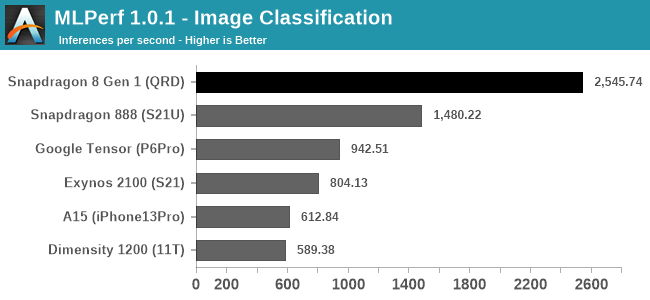
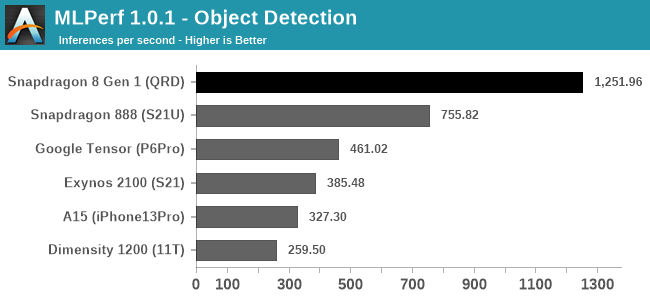
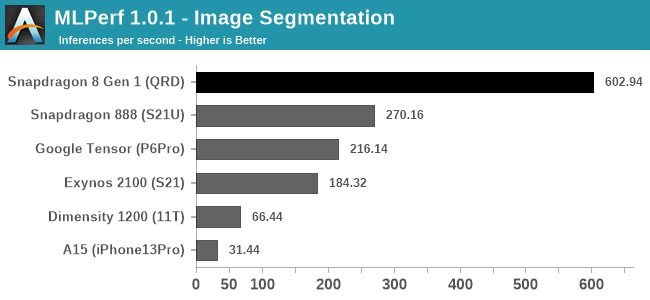
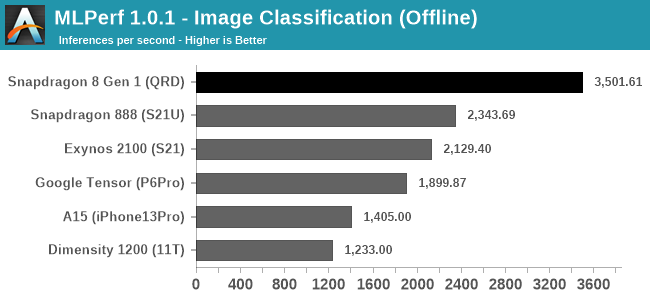
Across the board in these first four tests Qualcomm is making a sizable lead, going above and beyond what the S888 can do. Here we’re seeing up to a 2.2x result, making an average +75% gain. It’s not quite the 4x that Qualcomm promoted in its materials, but there’s a sizable gap with the other high-end silicon we’ve tested to date.
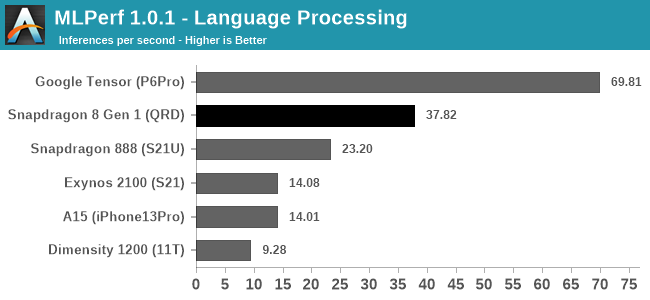
The only non-lead is with the language processing, where Google’s Tensor SoC is almost 2x what the S8g1 scores. This test is based on a mobileBERT model, and either for software or architecture reasons, it fits a lot better into the Google chip than any other. As smartphones increase their ML capabilities, we might see some vendors optimizing for specific workloads over others, like Google has, or offering different accelerator blocks for different models. The ML space is also fast paced, so perhaps optimizing for one type of model might not be a great strategy long-term. We will see.
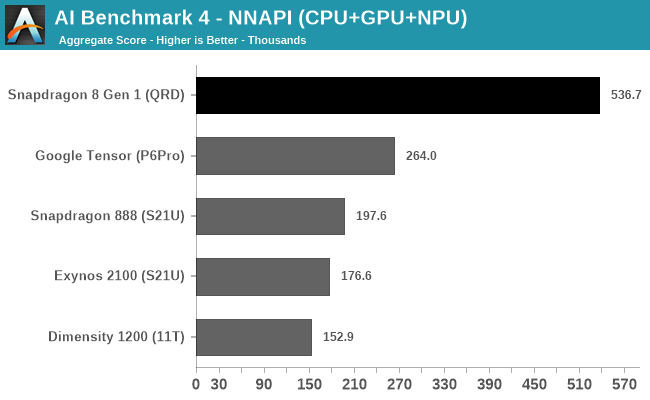
In AI Benchmark 4, running in pure NNAPI mode, the Qualcomm S8g1 takes a comfortable lead. Andrei noted in previous reviews with this test that the power consumed during this test can be quite high, up to 14 W, and this is where some chips might be able to pull ahead an efficiency advantage. Unfortunately we didn’t record power at the same time as the test, but it would be good to monitor this in the future.










169 Comments
View All Comments
StevoLincolnite - Wednesday, December 15, 2021 - link
We have reached a point where even a low-range phone is "good enough" for 90% of users out there... Usually the draw backs of those devices tend to be in the display (LCD) or camera sensors rather than how snappy the device is.Today I walked into a store to see what I could upgrade my Samsung Galaxy Note 20 Ultra 5G to.. It's been 18 months and from a camera and display perspective, nothing was really worth dropping another $2,000 AUD on... Because I am not going to perceive any difference in device snappiness... Even though I keep it in power saving mode 24/7 for increased battery life anyway.
TheinsanegamerN - Friday, December 17, 2021 - link
Moto g power 2020, has a snapdragon 665, 1080p display, and stereo speakers alongside a huge battery for $229. With phones like that, I have no idea why people were buying $1400+ flagships.Of course now manufacturers are cheaping out, using 720p displays and mediatek chips to push you towards their $500-600 mid range ptions.
Bd0N - Wednesday, December 15, 2021 - link
Here’s where having a processor that’s more than “fast enough” matters. Software grows in complexity over time and Apple’s devices get updates for 6-8 years. What may seem like unnecessary performance now ensures that devices feel snappy throughout their lifetime. Your S865 would be struggling to support software that much younger than it. But of course you don’t get updates for that long and that’s why iPhones have a higher resell value.nucc1 - Thursday, December 16, 2021 - link
I can buy another mid range android every 24 months to keep up with software bloat and still come out ahead in dollar terms vs iPhone :)TheinsanegamerN - Friday, December 17, 2021 - link
Android phones dont need updates to continue getting new software. You can buy an android phone running android 6 and still play all the latest games and apps.Iphones, OTOH, are screwed once updates stop for 1-2 years. Effectively both brands have the same lifespan, the difference being iphones are cut off by apple instead of developers.
iphonebestgamephone - Friday, December 17, 2021 - link
Wrong. Both the citra 3ds emulator and aethersx2 ps2 emulator need android 8 and 7 respectively. Genshin impact and dead by daylight need 7. There's prolly a lot more.Reflex - Monday, December 20, 2021 - link
This is factually incorrect, Google is fairly aggressively cutting off support for older versions of Android for app developers, and they are right to do so for security reasons. What they have not done is meaningfully extended the support lifecycle for hardware, so you get the worst of both worlds: Short support lifecycle and hardware that is decreasingly useful due to the app library thinning with every app update.Nicon0s - Saturday, December 18, 2021 - link
"Here’s where having a processor that’s more than “fast enough” matters. Software grows in complexity over time and Apple’s devices get updates for 6-8 years. What may seem like unnecessary performance now ensures that devices feel snappy throughout their lifetime. Your S865 would be struggling to support software that much younger than it."I wound wager that "his 865" will do just as fine long term as the A13, the generational equivalent from Apple. The CPU is no the only relevant component for performance when looking at a phone. Other component like RAM, Storage and Wireless connection efficiency and performance are also very very important. The A13 isn't even faster in multi-core which is just becoming more and more important as times goes by and especially with Android which a more multi-core oriented system than iOS.
Kangal - Sunday, December 19, 2021 - link
That's true.However, an iPhone will still age better than any Android device. That's the perks of having vertical integration. You'll have more optimised hardware, more optimised software, and more optimised third-party support.
For instance:
iPhone 5S (A7) vs (QSD 800) Samsung Note 3
iPhone 6S+ (A9) vs (QSD 810) Sony Z5 Premium
iPhone 8+ (A11) vs (QSD 835) Google Pixel 2XL
iPhone 11 Max (A13) vs (QSD 855) ASUS RoG 2
And these are what I thought were strong competitors. For general use stuff, Apple wins. While it has some obvious drawbacks. And I can admit this as an Android user, credit where it's due.
Nicon0s - Saturday, December 25, 2021 - link
"You'll have more optimised hardware, more optimised software, and more optimised third-party support."I keep hearing this but it's not like hardware and software is only integrated and optimized on Apple devices.
"And these are what I thought were strong competitors."
I don't think those "were strong competitors", you just picked a few random phones and compared them.
Like I've said the CPU is not the only relevant component. The SD 865 has a stronger GPU in sustained performance and much better connection performance. Also most SD 865 phones have 8GB of RAM. So in the long run it won't fare worse than iphones with the A13 as it's not a less capable and less efficient SOC it only scores lower in CPU benchmarks.